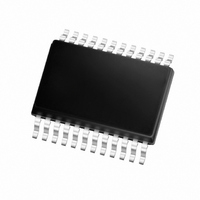MCP3909-I/SS Microchip Technology, MCP3909-I/SS Datasheet - Page 22

MCP3909-I/SS
Manufacturer Part Number
MCP3909-I/SS
Description
IC POWER METERING-1 PHASE 24SSOP
Manufacturer
Microchip Technology
Datasheets
1.MCP3909T-ISS.pdf
(44 pages)
2.MCP3909T-ISS.pdf
(104 pages)
3.MCP3909-ISS.pdf
(40 pages)
Specifications of MCP3909-I/SS
Package / Case
24-SSOP (0.200", 5.30mm Width)
Input Impedance
390 KOhm
Measurement Error
0.1%
Voltage - I/o High
2.4V
Voltage - I/o Low
0.85V
Current - Supply
2.3mA
Voltage - Supply
4.5 V ~ 5.5 V
Operating Temperature
-40°C ~ 85°C
Mounting Type
Surface Mount
Meter Type
Single Phase
Operating Temperature Range
- 40 C to + 85 C
Mounting Style
SMD/SMT
Supply Voltage Range
4.5V To 5.5V
Digital Ic Case Style
SSOP
No. Of Pins
24
Interface Type
Serial, SPI
Supply Voltage Max
5.5V
Rohs Compliant
Yes
Lead Free Status / RoHS Status
Lead free / RoHS Compliant
For Use With
MCP3909EV-MCU16 - EVALUATION BOARD FOR MCP3909MCP3909RD-3PH1 - REF DESIGN MCP3909 3PH ENGY MTR
Lead Free Status / Rohs Status
Lead free / RoHS Compliant
Available stocks
Company
Part Number
Manufacturer
Quantity
Price
Part Number:
MCP3909-I/SS
Manufacturer:
MICROCHIP/微芯
Quantity:
20 000
MCP3909
4.7
For the active power signal calculation, the MCP3909
uses a digital low-pass filter. This low-pass filter is a
first-order IIR filter, which is used to extract the active
real-power information (DC component) from the
instantaneous power signal. The magnitude response
of this filter is detailed in
the instantaneous power signal has harmonic content
(coming from the 2ω components of the inputs), and
since the filter is not ideal, there will be some ripple at
the output of the low-pass filter at the harmonics of the
line frequency.
The cut-off frequency of the filter (8.9 Hz) has been
chosen to have sufficient rejection for commonly-used
line frequencies (50 Hz and 60 Hz). With a standard
input clock (MCLK = 3.58 MHz) and a 50 Hz line
frequency, the rejection of the 2ω component (100 Hz)
will be more than 20 dB. This equates to a 2ω
component containing 10 times less power than the
main DC component (i.e., the average active real
power).
FIGURE 4-5:
(MCLK = 3.58 MHz).
The output of the low-pass filter is accumulated in the
digital-to-frequency converter. This accumulation is
compared to a different digital threshold for F
and HF
measured by the part. Every time the digital threshold
on F
pulse (See Section 4.8 “Active Power F
HF
The equivalent quantity of real energy required to
output a pulse is much larger for the F
than the HF
for the F
integration period acts as another low-pass filter so that
the output ripple due to the 2ω components is minimal.
However, these components are not totally removed,
since realized low-pass filters are never ideal. This will
create a small jitter in the output frequency. Averaging
the output pulses with a counter or a MCU in the
DS22025B-page 22
OUT
OUT0/1
-10
-15
-20
-25
-30
-35
-40
-5
Output Frequencies”).
0
OUT
0.1
Active Power Low-Pass Filter and
DTF Converter
OUT0/1
, representing a quantity of real energy
or HF
OUT
. This is such that the integration period
outputs is much larger. This larger
OUT
1
is crossed, the part will output a
LPF1 Magnitude Response
Frequency (Hz)
Figure
10
4-5. Due to the fact that
100
OUT0/1
OUT0/1
outputs
1000
OUT0/1
and
application will then remove the small sinusoidal
content of the output frequency and filter out the
remaining 2ω ripple.
HF
due to its instantaneous power content. The shorter
integration period of HF
component be given more attention. Since a sinusoidal
signal average is zero, averaging the HF
steady-state conditions will give the proper real energy
value.
4.8
The thresholds for the accumulated energy are
different for F
different transfer functions). The F
output frequencies are quite low in order to allow
superior integration time (see Section 4.7 “Active
Power Low-Pass Filter and DTF Converter”). The
F
following equation:
EQUATION 4-1:
For a given DC input V, the DC and RMS values are
equivalent. For a given AC input signal with amplitude
of V, the equivalent RMS value is V/ sqrt(2), assuming
purely sinusoidal signals. Note that since the real
power is the product of two RMS inputs, the output
frequencies of AC signals are half of the DC inputs
ones, again assuming purely sinusoidal AC signals.
The constant F
digital settings.
frequencies for the different logic settings.
Where:
OUT0/1
OUT
V
REF
F
V
V
is intended to be used for calibration purposes
G = the PGA gain on Channel 0 (current
C
0
1
output frequency can be calculated with the
Active Power F
Output Frequencies
F
OUT
= the RMS differential voltage on
= the RMS differential voltage on
= the frequency constant selected
= the voltage reference
(
Hz
OUT0/1
Channel 0
Channel 1
channel)
C
)
depends on the F
Table 4-2
=
F
OUTPUT EQUATION
8.06
---------------------------------------------------------- -
and HF
© 2009 Microchip Technology Inc.
OUT
OUT
×
OUT0/1
FREQUENCY
V
(
shows F
0
demands that the 2ω
V
OUT
×
REF
V
1
)
×
2
and HF
(i.e., they have
OUT0
G F
OUT0/1
OUT0/1
×
OUT
and F
C
signal in
allowed
OUT
output
OUT1













